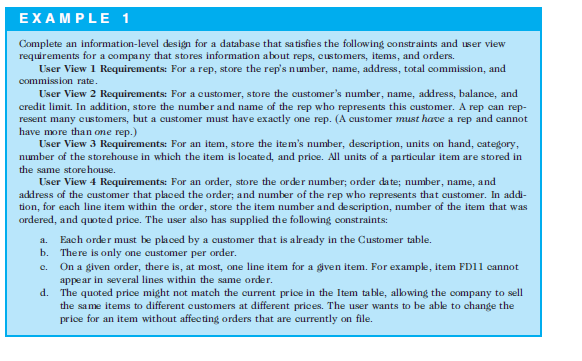Question
The following exercises are based on the TAL Distributors database as designed in Example 1 in this chapter. In each exercise, represent your answer in
The following exercises are based on the TAL Distributors database as designed in Example 1 in this chapter. In each exercise, represent your answer in DBDL and with a diagram. You may use any of the styles presented in this chapter for the diagram.

3. Indicate the changes you need to make to the design of the TAL Distributors database in the event User View 3 requirements are changed as follows: For an item, store the item's number, description, category, and price. In addition, for each storehouse in which the item is located, store the number of the storehouse, description of the storehouse, and number of units of the item stored in the storehouse.
EXA MPLE 1 Complete an information-level design for a database that sa tisfies the following constraints and user view requirements for a company that stores information about reps, customers, items, and orders. User View 1 Requirements: For a rep, store the rep's number, name, address, total commission, and commission rate User View 2 Requirements: For a customer, store the customer's number, name, address, balance, and credit limit. In addition, store the number and name of the rep who represents this customer. A rep can rep- resent many customers, but a customer must have exactly one rep. (A customer must have a rep and cannot have more than one rep.) User View 3 Requirements: For an item, store the item's number, description, units on hand, category number of the storehouse in which the item is located, and price. All units of a particular item are stored in the same store house. User View 4 Requirements: For an order, store the order number; order date; number, name, and address of the customer that placed the order; and number of the rep who represents that customer. In addi tion, for each line item within the order, store the item number and description, number of the item that was ordered, and quoted price. The user also has supplied the following constraints: a. Each order must be placed by a customer that is already in the Customer table. b There is onl c. On a given order, there is, at most, one line item for a gven item. For example, item FD11 cannot y one customer per order appear in several lines within the same order. The quoted price might not match the current price in the Item ta ble, allowing the company to sell the same items to different customers at different prices. The user wants to be able to change the price for an item without affecting orders that are currently on file. d. EXA MPLE 1 Complete an information-level design for a database that sa tisfies the following constraints and user view requirements for a company that stores information about reps, customers, items, and orders. User View 1 Requirements: For a rep, store the rep's number, name, address, total commission, and commission rate User View 2 Requirements: For a customer, store the customer's number, name, address, balance, and credit limit. In addition, store the number and name of the rep who represents this customer. A rep can rep- resent many customers, but a customer must have exactly one rep. (A customer must have a rep and cannot have more than one rep.) User View 3 Requirements: For an item, store the item's number, description, units on hand, category number of the storehouse in which the item is located, and price. All units of a particular item are stored in the same store house. User View 4 Requirements: For an order, store the order number; order date; number, name, and address of the customer that placed the order; and number of the rep who represents that customer. In addi tion, for each line item within the order, store the item number and description, number of the item that was ordered, and quoted price. The user also has supplied the following constraints: a. Each order must be placed by a customer that is already in the Customer table. b There is onl c. On a given order, there is, at most, one line item for a gven item. For example, item FD11 cannot y one customer per order appear in several lines within the same order. The quoted price might not match the current price in the Item ta ble, allowing the company to sell the same items to different customers at different prices. The user wants to be able to change the price for an item without affecting orders that are currently on file. dStep by Step Solution
There are 3 Steps involved in it
Step: 1

Get Instant Access to Expert-Tailored Solutions
See step-by-step solutions with expert insights and AI powered tools for academic success
Step: 2

Step: 3

Ace Your Homework with AI
Get the answers you need in no time with our AI-driven, step-by-step assistance
Get Started


